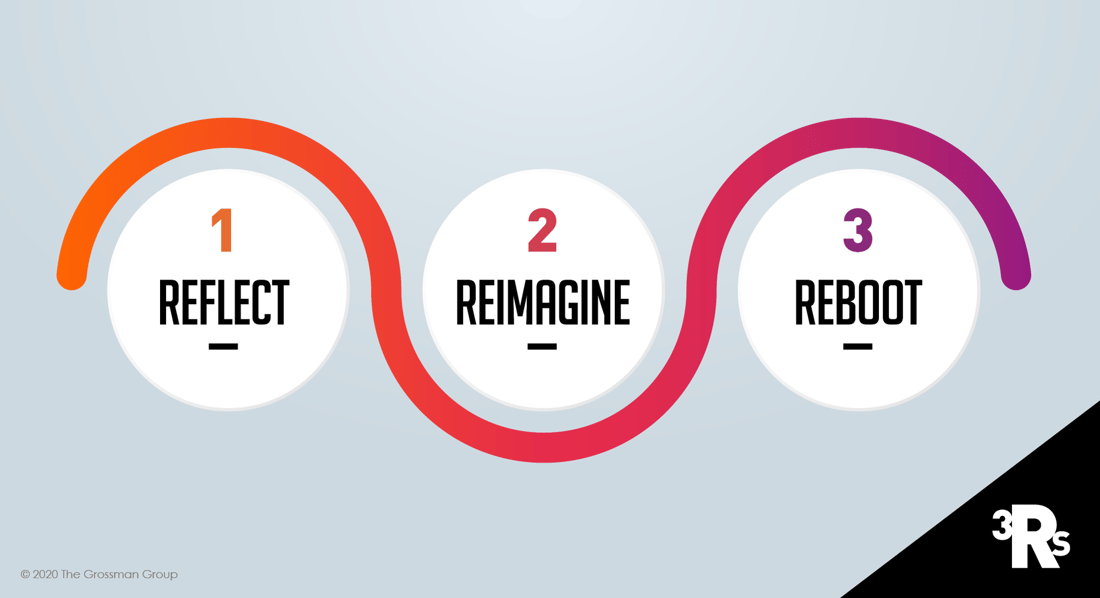September 21, 2020
3Rs Internal Communication Model: 3 Steps to Reboot Internal Communications Through COVID-19
Written by:
David Grossman

What a wild ride 2020 has been.
From a business perspective soon after we celebrated the New Year, companies with operations in China jumped right into the challenges related to COVID-19 and the rest of the world began to feel the impact of COVID-19 toward the end of the first quarter as the seriousness of the pandemic became real.
As leaders and communicators, we focused on keeping people safe and trying to help them understand the impact on business. Work went virtual for those who could. The focus turned to essential workers and supporting them. Record unemployment. Social unrest and attention towards systemic inequity came to the forefront. Political intensity rose around the world and especially in the U.S. with an election of global implications. Countries and communities wrestled with how to get children back to school safely and for people’s lives to try to “return to normal” – even as everything is anything but normal.
Personally, many of us have found ourselves in a swirling snow globe of emotions: disbelief, despair, confusion, grief, anger, rage, compassion, kindness, hope and possibility mixed in. All this is happening around us. Everything swirling.
At The Grossman Group, we started the year – our 20th anniversary year – doing what we do best: helping organizations transform culture, activate strategy, build stronger leaders and communicators. We quickly shifted as well to support organizations during the pandemic, amidst the social unrest, and as organizations made diversity, equity and inclusion the priority it needs to be. Our work became even more high stakes to help organizations navigate change and leaders connect with their people in new and meaningful ways on difficult topics that people were grappling with in their personal and work lives.
It’s in that context that we share with you an approach you can use to take the learnings of this year and build an even better internal communications function for next year and beyond.
3Rs Internal Communications Model to Reboot Internal Communications Through COVID-19
We created the 3Rs Internal Communications Model to help you continue to lead in your vital role as a business communicator.
- REFLECT: Diagnose where you are and what you’ve learned from the past year. Think about what worked, what didn’t, what you want to keep and most importantly, what your organization needs.
- REIMAGINE: Draw on the data and insights from REFLECT and envision what’s possible. Create your plan for the ideal communications approach and infrastructure given the current business context. Be creative, challenge assumptions and answer the question, what if?
- REBOOT: A plan without action is just a piece of paper with words on it. This is when you activate your plan.
Use the 3Rs Internal Communications Model to help you know where you are and be disciplined in thinking about where you need and want your function to be.
- Think of this model as a cycle that can be repeated and reinforced many times. As you implement new ideas, you’ll learn and find more opportunities.
- You may be in different places in this model depending on your goals. Perhaps you implemented a great new leader platform that you think should continue, but you are “backsliding” on message focus and consistency. Plan for those differences.
- It can be challenging to step out of the day-to-day and find the time to do the work of questioning what you’re doing and dreaming about bigger or better ways of working. It’s worth it though; if you fully invest in each step of the process, you will see positive change.

Reflect on Your Internal
Communications During the Pandemic
The Reflect stage is intended to be honest in looking back, and to build a measurable platform for how you want to implement your Communication Plan 2.0 to meet the needs of the business.
Throughout the pandemic, we’ve heard a great many anecdotal stories about things that worked and things that didn’t, including internal communications. In the Reflect phase, move beyond the anecdotal and do an “after action review” to test your experience. Be honest so that you can think through how to build an even better function for the future.
- Do a complete inventory to start to build a hypothesis about your Communication Plan 2.0. Do this on your own and engage your team and key stakeholders – such as business partners, leadership, key decision makers and employees – in the process.
The inventory will help you uncover truths about:- The strength of systems, approaches and infrastructure in place and ability to adapt
- How to deliver communications to reach employees
- How communications are received
- How well you know your audiences and their information needs and perceptions
- How ready people leaders are to communicate in times of change
- Whether communications on certain topics are critical or not
- Perceptions of stakeholders who you need as champions or for funding
- And so many other things to help guide sound decision making
- Test the hypothesis with data. Move away from personal preferences and probe on what worked. For example, if someone expresses a preference for a certain type of communication, challenge whether it fits into the needs of the company going forward. People will often add requests, but this is the opportunity to apply rigor, challenge the request, and see if it drives the company forward.
Look beyond communications data and get to the heart of your organization’s business metrics that matter. For many organizations that could mean behaviors that employees need to change or adopt, customer and customer support metrics, business metrics/KPIs, and the like.
Take inventory with our free Internal Communications Inventory Worksheet. Use it to map what’s needed (and what’s not) for long-term success:

Reimagine Your Internal
Communications for the Future
You’ve done the analysis and gathered the data, and now is the time to ask, What if? What if we rebuilt…or reimagined…our function, our processes and our infrastructure? If we need to rebuild, what would we need it to be given today’s context? What if we reimagined our relationships with other parts of the business to deliver even more effectively and with greater value?
The deliverable of this step is a plan that is based in data, a clear understanding of business success that not only clarifies what is important for the organization. This sets you up for the third phase of the model – which is to execute and implement your communications plan.
Reimagine doesn’t mean everything should be new. You likely will have approaches and systems that you relied on that are even more important than before. Use your work from Reflect as a springboard to think about what communications can be.
- Begin with the end in mind. Define success and an end-state vision for you and your function. Be clear in your definition of the role you play and the value you bring to the organization. Keep that definition focused and narrow.
Too often, the value of communications isn’t held to an objective standard, but it’s determined by the different opinions and visions of different stakeholders – many of whom may or may not be focused on the same goal or see it the same way. For example, if your role is to help the organization understand and stay focused on the strategic goals of the organization, including business continuity, then that’s your priority. Everything else should rank below or in service to that role – or it’s not in your area of responsibility.
Clearly defining that role and not trying to be all things to all people isn’t easy. But what the pandemic taught us is that things that are prioritized get done and get results. Make that priority clear for both you and your company. - Put yourself in the shoes of your audience and define what they need for you and the company to be successful. Your role is to build clarity, not deliver content. That’s a big difference. Once you’ve defined what success looks like, begin building the structure that makes that success a reality.
- Challenge things that feel like “nice to haves.” I bet you’re already seeing leaders and organizations producing information for their teams that is, at best, unnecessary and at worst, distracting. Do you want a system that makes all those items “feel” equal, or would you rather a system that focuses on what matters most for performance?
- Prioritize ruthlessly. This may be a new role, but it’s critical. We’ve seen that narrowing the focus of employees on a few priorities allows them to move mountains. If you can maintain this level of clarity, enlist the aid of senior leadership to keep the messages to three or four at most above the daily job information, you will see your organization rise to the challenges that may have once seemed insurmountable.
- Engage important stakeholders in the process. Don’t reimagine your function in isolation. Bring in key business partners to envision what’s possible together for more collective ownership and even better outcomes. Consider ways HR, IT or other functions could be even more connected to what Internal Communications is trying to accomplish. Reimagine how they could contribute expertise – or resources – to address the needs of the business.
Preparing a clear business case is a best practice that I’d like to see become more common practice for internal communications functions. It takes the work done in the Reflect and Reimagine steps and puts it into terms that you, your team and key business stakeholders can understand so they see your vision and what solutions you recommend to advance business needs.
 Your business case can be a means for engaging stakeholders strategically so you get more of what you need to advance business outcomes – whether that’s building a coalition of partners, gaining champions, securing financial backing or all of the above.
Your business case can be a means for engaging stakeholders strategically so you get more of what you need to advance business outcomes – whether that’s building a coalition of partners, gaining champions, securing financial backing or all of the above.
Your business case should answer 4 main questions:
- What’s the need?
- What’s the value we can create for the business by doing things in a new/different way?
- What’s the cost of not doing something?
- How do we get this done in the best way?
Ready to build your business case? Download the free “Build Your Business Case for Internal Communications” template and guide to get started.

Reboot Your Internal Communications
for Long-Term Success
You’ve done the work. You have a plan to reimagine for your function. Your goal is to create a new and better status quo. Now you need to reboot, staying strong and diligent in the implementation along the way.
As you Reboot internal communications through COVID-19, ask yourself if you’re delivering on the ideas you developed in the first two steps:
- “Does this support the strategic goals of the organization?”
- “Are we holding true to what the audience needs to stay focused on?”
- “Are we achieving clarity and driving the needs of the organization for today and tomorrow.”
Rebooting communications for the new and better normal is going to have to happen while we continue to work and deliver. Don’t let perfect be the enemy of progress. Reflect on lessons learned and implement where your organization needs it the most and when opportunities present themselves.
Weigh Your Team’s Competencies
As you Reflect, Reimagine and Reboot internal communications through COVID-19, there’s one more variable to consider – your and your team’s competencies. What do you need to do to deliver even better in the future? What data and insights do you have about what employees want? A larger budget? Adapt your communications system? All of this is interconnected with your team and how ready you are to deliver on what’s needed.
As you think about being even better, consider where you and your team are with these skill sets:
- Alignment with leadership: Getting leadership on board with your plans, and engaging their active participation
- Strategic counsel and support: Ongoing counsel and truth-telling required to help leadership with the right actions and words
- Technical skills and tools: Having the right infrastructure and tools to get the message out
- Content creation: Setting the narrative that reflects the organization’s strategy, culture and priorities
- Vehicle selection: Picking the right channels based on audience preferences
- Resources and support: Having the right people and dollars resources to deliver – whether in-house or with external partners
- Delivery: Getting the tactical work completed
- Measurement: Having data to inform the strategy and ongoing decisions
Whether a team of one or many, consider which of these directly apply to your role and function and what you reimagine it to be. Then, check how comfortable and competent you are at these. This will help you know where to focus, and/or where you need more support either from inside the organization and/or outside resources.
To measure your comfort and competencies with these key skills, download the “Weigh Your Team’s Communications Competencies” assessment tool.
If there was a 4th R to the model, it’d be Resist … resist the urge to go this alone. We’ve been here before with many communications teams and can help you avoid planning pitfalls and make the most of your valuable time and energy.
 We recently facilitated a session with the Internal Communications team at a global company to Reflect. This allowed everyone on the team to participate fully and equally. The Reflect work led to a synthesis of key observations and learnings. In one day, they committed to a list of what they would Start, Stop and Keep doing. For a group that had been stuck in “swirl” and were challenged to say no, this was a big forward step. They also identified where they needed additional stakeholder input and data.
We recently facilitated a session with the Internal Communications team at a global company to Reflect. This allowed everyone on the team to participate fully and equally. The Reflect work led to a synthesis of key observations and learnings. In one day, they committed to a list of what they would Start, Stop and Keep doing. For a group that had been stuck in “swirl” and were challenged to say no, this was a big forward step. They also identified where they needed additional stakeholder input and data.
This led to Reimagine. We worked with the team to shape a new vision for the function and map a plan for how to get there. They built a strong business case and socialized their plan across their networks of business partners and leaders to build a coalition of partners to help advance their vision for internal communications.
Working the smart approach set them up for success to Reboot their function.
There Are Silver Linings, Even in the Darkest of Clouds
This “year that was” changed people in lasting ways and it reminds us that we all depend on each other (even when we’re far apart), that change can happen when people unite around a common goal, and to never let a crisis go to waste.
As you Reflect, Reimagine and Reboot internal communications in your organization:
- Continue to listen for what employees need and want.
- Use this moment to get feedback from senior leadership and gain a deeper understanding of their goals and priorities.
- Keep it real and say it in plain language – authenticity matters more than ever.
- Don’t duck the tough subjects – find ways to facilitate respectful conversations.
- Be bold and think big. Times of crisis are times of opportunity and change is a great time for change.
- Don’t go it alone – seek out partnerships, work your network and get outside help for ideas and learning.
How might following the 3Rs Internal Communications Model set your function up for long term success? What’s stopping you from Reimagining what’s possible and Rebooting?
—David Grossman
We help communications teams evolve their overall strategy, build the business case they need to get leader buy-in and execute the plan. If you need help with one or more of those components, we’d be happy to partner with you.
Tag(s):
Internal Communication
Other posts you might be interested in
View All Posts
Internal Communication
24 min read |
September 11, 2023
Internal Communications Plan: 7-Step Strategy and Template
Read More
Internal Communication
3 min read |
January 23, 2023
3 Tips for Crystal Clear Internal Communications
Read More
Internal Communication
14 min read |
September 26, 2022






Comments on this post